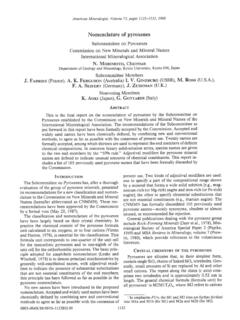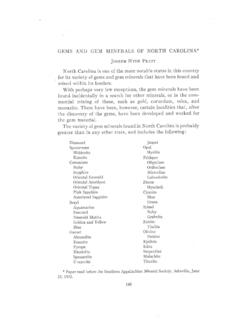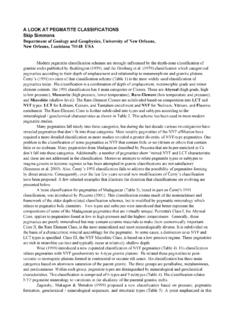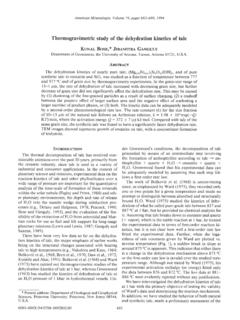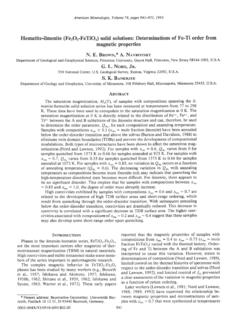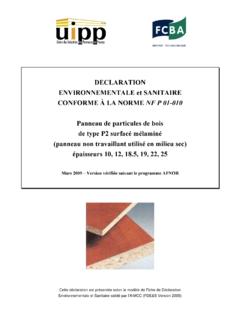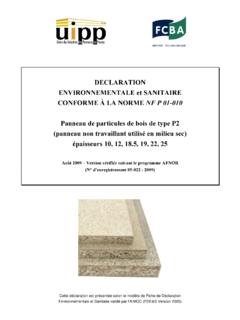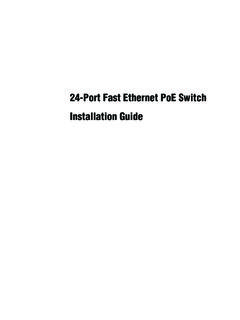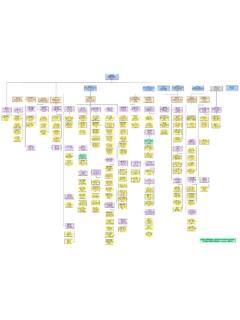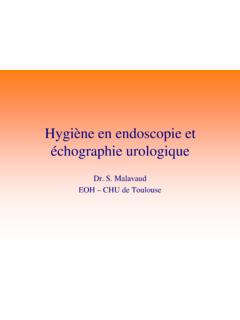Transcription of NOMENCLATURE OF AMPHIBOLES: REPORT OF THE …
1 219 The Canadian MineralogistVol. 35, pp. 219-246 (1997) NOMENCLATURE OF AMPHIBOLES: REPORT OF THE SUBCOMMITTEE ONAMPHIBOLES OF THE INTERNATIONAL MINERALOGICAL ASSOCIATION,COMMISSION ON NEW MINERALS AND MINERAL NAMESBERNARD E. LEAKE1(Chairman)Department of Geology and Applied Geology, University of Glasgow, Glasgow G12 8QQ, R. WOOLLEY (Secretary)Department of Mineralogy, Natural History Museum, Cromwell Road, London SW7 5BD, ARPS* (The Netherlands; retired December 1994)WILLIAM D. BIRCH* (Australia; from January 1995)M. CHARLES GILBERT ( ; resigned 1994)JOEL D. GRICE (Canada; *from January 1995)Mineral Sciences Division, Canadian Museum of Nature, Box 3443, Station D, Ottawa, Ontario K1P 6P4, CanadaFRANK C. HAWTHORNED epartment of Earth Sciences, University of Manitoba, Winnipeg, Manitoba R3T 2N2, CanadaAKIRA KATOD epartment of Geology, Natural Science Museum, 2-23-1 Hyakanin-cho, Shinjuka, Tokyo 160, JapanHANAN J.
2 KISCHD epartment of Geology and Mineralogy, Ben Gurion University of the Negev, Box 653, 84105 Beer Sheva, IsraelVLADIMIR G. KRIVOVICHEVF aculty of Geology, St. Petersburg University, University Emb. 7/9, 199034 St. Petersburg, RussiaKEES LINTHOUTD epartment of Ore Geology, Petrology and Mineralogy, Institute of Earth Sciences, Free University,De Boelelaan 1085, 1081 HV Amsterdam, The NetherlandsJO LAIRDD epartment of Earth Sciences, College of Engineering and Physical Sciences, University of New Hampshire,Durham, New Hampshire 03824, A. MANDARINO* (Canada; retired December 1994)WALTER V. MARESCHI nstitut f r Mineralogie, Ruhr-Universit t Bochum, D-44780 Bochum, GermanyERNEST H. NICKEL* (Australia)NICHOLAS ROCK (Australia; died February 1992)JOHN C. SCHUMACHERI nstitut f r Mineralogie-Petrologie-Geochemie der Albert-Ludwigs Universit t zu Freiburg, Albertstrasse 23b,D-79104 Freiburg, GermanyDAVID C.
3 SMITH (France; resigned 1994)NICK STEPHENSOND epartment of Geology and Geophysics, University of New England, Armidale, New South Wales 2351, AustraliaLUCIANO UNGARETTI (Italy; resigned April 1993)ERIC WHITTAKER60 Exeter Road, Kidlington, Oxford OX5 2DZ, YOUZHIC entral Laboratory, Bureau of Geology and Mineral Resources of Hunnan Province, Dashiba, Kunming, China*Indicates a nonvoting official of the address: Jul 16 21:11:45 1998 Plate: 1 of 1 Color profile: DisabledBlack 133 lpi at 45 degreesABSTRACTThe International Mineralogical Association s approved amphibole NOMENCLATURE has been revised in order to simplify it,make it more consistent with divisions generally at 50%, define prefixes and modifiers more precisely, and include new speciesof amphibole discovered and named since 1978, when the previous scheme was approved.
4 The same reference axes form thebasis of the new scheme, and most names are little changed, but compound species names like tremolitic hornblende (nowmagnesiohornblende) are abolished, as are crossite (now glaucophane or ferroglaucophane or magnesioriebeckite or riebeckite),tirodite (now manganocummingtonite) and dannemorite (now manganogrunerite). The 50% rule has been broken only to retaintremolite and actinolite as in the 1978 scheme; the sodic calcic amphibole range has therefore been expanded. Alkali amphibolesare now sodic amphiboles. The use of hyphens is defined. New amphibole names approved since 1978 include nyb ite, leakeite,kornite, ungarettiite, sadanagaite and cannilloite. All abandoned names are listed. The formulae and source of the amphiboleend-member names are listed, and procedures outlined to calculate Fe3+and Fe2+where not determined by :amphibole NOMENCLATURE , crossite, dannemorite, sch ma de NOMENCLATURE approuv de l Association min ralogique internationale est ici r vis afin de le simplifier, de lerendre plus conforme la r gle des subdivisions 50%, d en d finir plus pr cis ment les pr fixes et les qualificatifs, et d y inclureles nouvelles esp ces d couvertes et approuv es depuis 1978, date de publication du rapport ant rieur.
5 Les m mes axes der f rence sont retenus dans le nouveau sch ma, et la plupart des noms sont peu chang s. En revanche, les noms d esp cecompos s, par exemple hornblende tr molitique (d sormais magn siohornblende), sont abolis, de m me que crossite (d sormaisglaucophane, ferroglaucophane, magn sioriebeckite ou riebeckite), tirodite (d sormais manganocummingtonite) et dannemorite(d sormais manganogrunerite). La r gle de 50% n est transgress e que pour le maintien des esp ces tr molite et actinolite, dontla d finition reste inchang e depuis le rapport de 1978, de telle sorte que le domaine occup par les amphiboles sodiques calciques s en trouve agrandi. Les amphiboles alcalines sont maintenant appel es amphiboles sodiques. L utilisation des traitsd union est pr cis e.
6 Les esp ces d amphibole suivantes ont t approuv es depuis 1978: nyb ite, leake te, kornite, ungarettiite,sadanaga te et cannillo te. Tous les noms mis l cart sont indiqu s. Nous donnons la formule chimique et l origine des nomsdes p les des amphiboles, ainsi que les proc dures pour calculer la proportion de Fe3+et de Fe2+dans les cas o elle n a pas t d termin e directement.(Traduit par la R daction)Mots-cl s: NOMENCLATURE , amphiboles, crossite, dannemorite, REPORT was produced in response to a motion atthe IMA 1986 meeting in Stanford, California, askingthe CNMMN to produce a more simplified nomencla-ture of amphiboles than that currently approved, whichdates from 1978. The 1978 NOMENCLATURE (IMA 78)took over 13 years to formulate; a quicker response wasattempted this ensure a fresh look at the NOMENCLATURE scheme,the Chairman of the Amphibole Subcommittee, Leake, with the agreement of the CNMMN offi-cials, completely reconstituted the committee so that (1)representation was more international; (2) more than80% of the voting members of the committee were notmembers of the committee that produced the 1978report; in addition, none of the CNMMN officials wason the 1978 committee; (3) three members wereretained from the 1978 committee to ensure that therewas some continuity and collective memory of the mainproblems that had been dealt with previously.
7 (4) rep-resentation included the principal proposer to theCNMMN of an improved scheme of NOMENCLATURE ;(5) representation was sought across the various fieldsconcerned with amphibole NOMENCLATURE , from crystal-chemists, metamorphic and igneous petrologists tocomputer experts and ordinary broad-based petrolo-gists. There were 18 voting members when the majorframework of the revised scheme was committee circulated over 1000 pages over nineyears, and considered in detail all proposals made to were expressed that because the amphibolesystem is so complicated, adequate representation can-not be made with two- and three-dimensional diagrams,whereas four variables can represent the systemadequately. However, the committee, by a very largemajority, wanted to retain conventional NOMENCLATURE -diagrams because they are easier for most scientists touse.
8 The committee considered a range of differentschemes of NOMENCLATURE , but none was judged overallto be sufficiently better to justify abandoning the mainbasis of IMA 78, which has been widely accepted andis capable of simplification to provide an improvedscheme. It must be remembered that over 95% of allamphibole analyses are currently obtained by electronmicroprobe, with no structural information, no knowledge50220 THE CANADIAN Jul 16 21:11:46 1998 Plate: 1 of 1 Color profile: DisabledBlack 133 lpi at 45 degreesof the oxidation states of Fe, Ti and Mn, the H2 Ocontent, or how the site populations are derived. Whatfollows is a scheme ofnomenclature, not one to deter-mine at which position the ions really are proposed scheme involves reducing the numberof subdivisions, especially in the calcic amphiboles,making the divisions generally follow the 50% rule(whereas IMA 78 uses divisions at 90%, 70%, 67%,50%, 33%, 30% and 10%), and making the use ofadjectival modifiers (additional to prefixes that are partof the basic names) optional.
9 The new scheme has over20 fewer names than IMA 78, and involves the aboli-tion of only a few commonly used names, such ascrossite. End-member formulae defined and approvedin IMA 78 are generally retained, although the rangesto which they apply have commonly been on the etymology, the type locality, and theunit-cell parameters of thirty end-members is providedin Appendix principal reference-axes of IMA 78, namely Si,NaBand (Na + K)A(see below), are retained, but theprimary divisions between the calcic, sodic calcic andalkali (renamed sodic) amphiboles have been adjustedto divisions at NaB< and NaB , instead ofNaB< and NaB (Here, and elsewhere in thisreport, concentrations are expressed in atoms performula unit of the standard formula of an amphibolegiven below.)
10 Previously, the amphibole box wasdivided into three equal volumes with respect to new scheme enlarges the sodic calcic amphibolesat the expense of the calcic and sodic amphiboles(Fig. 1) in order to make the divisions at 50% with the 1978 scheme, the problem of what to dowith analyses in which only the total iron is known (andnot its division into FeO and Fe2O3) has been left toindividual judgement, although a recommended proce-dure is given. This means that again an analysis mayyield different names depending upon the procedureused to estimate Fe3+and Fe2+. It clearly would beadvantageous,for purposes of namingan amphibole, ifthe recommended procedure were followed, even ifother procedures were used for other works dealing with the amphiboles includeDeeret al.
